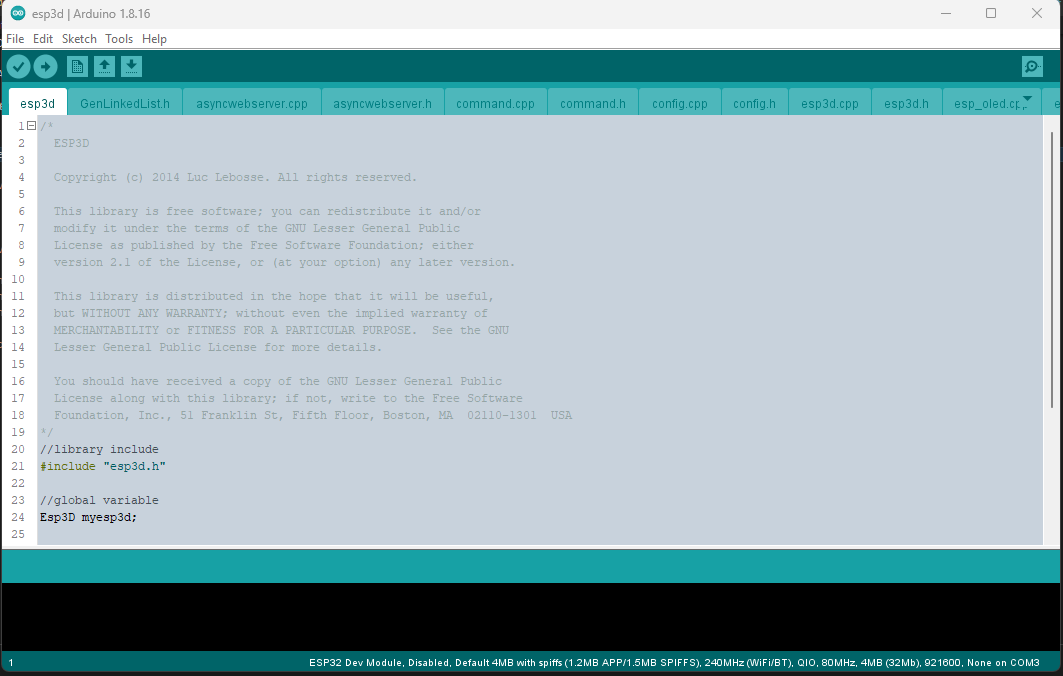Prepare the development environment
- Please download ide from https://www.arduino.cc/en/software
Note
Please use the Legacy IDE (1.8.X), the Arduino IDE 2.X was not tested and won't be supported
- Install the esp core according your target:
☛ If ESP8266
Note
Please use the version 2.5.2 or 2.7.4 only! Do not use any version upper than 2.7.4
☛ If ESP32
Note
Please use the version 1.0.4 only! Do not use any version upper than 1.0.4, and only use ESP32 board, other ESP32 flavors(C2, S2, S3, etc) are not supported in this version.
- Copy the content of the libraries directory to your arduino library directory.
Note
Do not try any version different than the ones provided, they may not work properly.
Open esp3d/esp3d.ino file in Arduino IDE

ESP3D configuration
Open esp3d/config.h and set features you want.
//Customize ESP3D ////////////////////////////////////////////////////////////////////////
#define ESP8266_MODEL_NAME "ESP8266"
#define ESP8266_MODEL_URL "http://espressif.com/en/products/esp8266/"
#define ESP32_MODEL_NAME "ESP32"
#define ESP32_MODEL_URL "https://www.espressif.com/en/products/hardware/esp-wroom-32/overview"
#define ESP_MODEL_NUMBER "ESP3D 2.1"
#define ESP_MANUFACTURER_NAME "Espressif Systems"
#define ESP_MANUFACTURER_URL "http://espressif.com"
//default name if no mac address is valid
#define ESP_DEFAULT_NAME "MYESP"
//if commented name will follow mac address 3 last digits
//like ESP_XXXXXX (eg:ESP_028E41) to avoid overlap if several ESP3D
#define ESP_HOST_NAME ESP_DEFAULT_NAME
//To allow webupdate using small updater
//#define USE_AS_UPDATER_ONLY
//FEATURES - comment to disable //////////////////////////////////////////////////////////
//WEB_UPDATE_FEATURE: allow to flash fw using web UI
#define WEB_UPDATE_FEATURE
#ifndef USE_AS_UPDATER_ONLY
//Do we use async webserver or not (currntly deprecated do not enable it yet)
//#define ASYNCWEBSERVER
//SERIAL_COMMAND_FEATURE: allow to send command by serial
#define SERIAL_COMMAND_FEATURE
//TCP_IP_DATA_FEATURE: allow to connect serial from TCP/IP
#define TCP_IP_DATA_FEATURE
//NOTIFICATION_FEATURE : allow to push notifications
#define NOTIFICATION_FEATURE
//MKS TFT WIFI support see Wiki for wiring
//#define MKS_TFT_FEATURE
//MDNS_FEATURE: this feature allow type the name defined
//in web browser by default: http:\\esp8266.local and connect
#define MDNS_FEATURE
//SSDD_FEATURE: this feature is a discovery protocol, supported on Windows out of the box
#define SSDP_FEATURE
//NETBIOS_FEATURE: this feature is a discovery protocol, supported on Windows out of the box
//#define NETBIOS_FEATURE
//CAPTIVE_PORTAL_FEATURE: In SoftAP redirect all unknow call to main page
#define CAPTIVE_PORTAL_FEATURE
//RECOVERY_FEATURE: allow to use GPIO2 pin as hardware reset for EEPROM, add 8s to boot time to let user to jump GPIO2 to GND
//#define RECOVERY_FEATURE
//DIRECT_PIN_FEATURE: allow to access pin using ESP201 command
#define DIRECT_PIN_FEATURE
//ESP_OLED_FEATURE: allow oled screen output
//#define ESP_OLED_FEATURE
//DHT_FEATURE: send update of temperature / humidity based on DHT 11/22
//#define DHT_FEATURE
//AUTHENTICATION_FEATURE: protect pages by login password
//#define AUTHENTICATION_FEATURE
//WS_DATA_FEATURE: allow to connect serial from Websocket
#define WS_DATA_FEATURE
//TIMESTAMP_FEATURE: Time stamp feature on direct SD files
//#define TIMESTAMP_FEATURE
#endif //USE_AS_UPDATER_ONLY
//Extra features /////////////////////////////////////////////////////////////////////////
//Workaround for Marlin 2.X coldstart
//#define DISABLE_CONNECTING_MSG
//Serial rx buffer size is 256 but can be extended
#define SERIAL_RX_BUFFER_SIZE 512
//Serial Parameters
#define ESP_SERIAL_PARAM SERIAL_8N1
//which serial ESP use to communicate to printer (ESP32 has 3 serials available, ESP8266 only one)
//Uncomment one only
#define USE_SERIAL_0
//For ESP32 Only
//#define USE_SERIAL_1
//#define USE_SERIAL_2
//Pins Definition ////////////////////////////////////////////////////////////////////////
//-1 means use default pins of your board what ever the serial you choose
#define ESP_RX_PIN -1
#define ESP_TX_PIN -1
#ifdef RECOVERY_FEATURE
//pin used to reset setting
#define RESET_CONFIG_PIN 2
#endif
#ifdef DHT_FEATURE
#define ESP_DHT_PIN 2
#endif
//Pins where the screen is connected
#ifdef ESP_OLED_FEATURE
#define OLED_DISPLAY_SSD1306 // OLED Display Type: SSD1306(OLED_DISPLAY_SSD1306) / SH1106(OLED_DISPLAY_SH1106), comment this line out to disable oled
#define OLED_PIN_SDA 4 //5 //SDA; // i2c SDA Pin
#define OLED_PIN_SCL 15 //4 //SCL; // i2c SCL Pin
#define OLED_ADDR 0x3c
#define HELTEC_EMBEDDED_PIN 16 //0 to disable
#define OLED_FLIP_VERTICALY 1 //0 to disable
#endif
Configure Flash settings
For ESP8266 with 4MB of flash
- Board: Generic ESP8266 Module
- Upload Speed: 115200
- CPU frequency: 160 MHz
- Flash Size: 4M (2M SPIFFS)
- Flash Mode: DIO
- Flash Frequency: 40Mhz
- Reset Method: CK
- Debug Port: Disabled
- Debug Level: None
For ESP8266 with 1MB of flash (this one may not support Web Update due to limited flash size)
- Board: Generic ESP8266 Module
- Upload Speed: 115200
- CPU frequency: 160 MHz
- Flash Size: 1M (128K SPIFFS)
- Flash Mode: DIO
- Flash Frequency: 40Mhz
- Reset Method: CK
- Debug Port: Disabled
- Debug Level: None
For ESP32 with 4MB of flash
- Board: ESP32 Dev Module
- Upload Speed: 115200
- CPU frequency: 240 MHz
- Flash Frequency: 80Mhz
- Flash Mode: QIO
- Flash Size: 4MB
- Partition Scheme: Default 4MB with SPIFFS
- Core Debug Level: None
- PSRAM: Disabled
Connect your board
Compile and flash your module
Select the port you device is connected to and select Upload from sketch menu to compile and flash.
